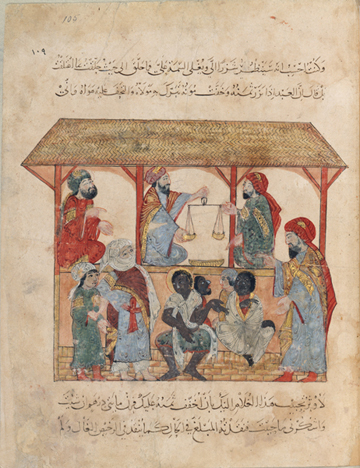

Slave Market in Yemen, 1237
Al-Maqamat, folio 105. Author: al-QÄsim ibn AlÄ« al HarÄ«rÄ« al-BasrÄ«. Illuminator: Yahya ben Mahmud al-Wasiti. Bibliothèque nationale de France. 021, an enslaved Ethiopian, Najah, seized power in the city of Zabid. This image represents the slave market at Zabid—at the time the capital of Yemen—in 1237. The illustration is part of “Al-Maqamat†(Assemblies), a genre of rhymed prose narrative. Both the author and the illuminator of this work were born in Iraq.
The Schomburg Center for Research in Black Culture has posted online a very nice exhibition on the African diaspora in the Indian Ocean World with illustrations and scholarly text.
Over the course of nearly 20 centuries, millions of East Africans crossed the Indian Ocean and its several seas and adjoining bodies of water in their journey to distant lands, from Arabia and Iraq to India and Sri Lanka.
Called Kaffir, Siddi, Habshi, or Zanji, these men, women and children from Sudan in the north to Mozambique in the south Africanized the Indian Ocean world and helped shape the societies they entered and made their own.
Free or enslaved, soldiers, servants, sailors, merchants, mystics, musicians, commanders, nurses, or founders of dynasties, they contributed their cultures, talents, skills and labor to their new world, as millions of their descendants continue to do. Yet, their heroic odyssey remains little known.
The African Diaspora in the Indian Ocean World traces a truly unique and fascinating story of struggles and achievements across a variety of societies, cultures, religions, languages and times.

Men in Arabia
C. Snouck Hurgronje (Christiaan Snouck), Bilder aus Mekka, mit kurzem erläuterndem